what two scales do geologists use to measure time
Measuring Geological Time
Adjusted from Physical Geology, Beginning University of Saskatchewan Edition (Tim Prokopiuk and Karla Panchuk) and Physical Geology (Steven Earle)
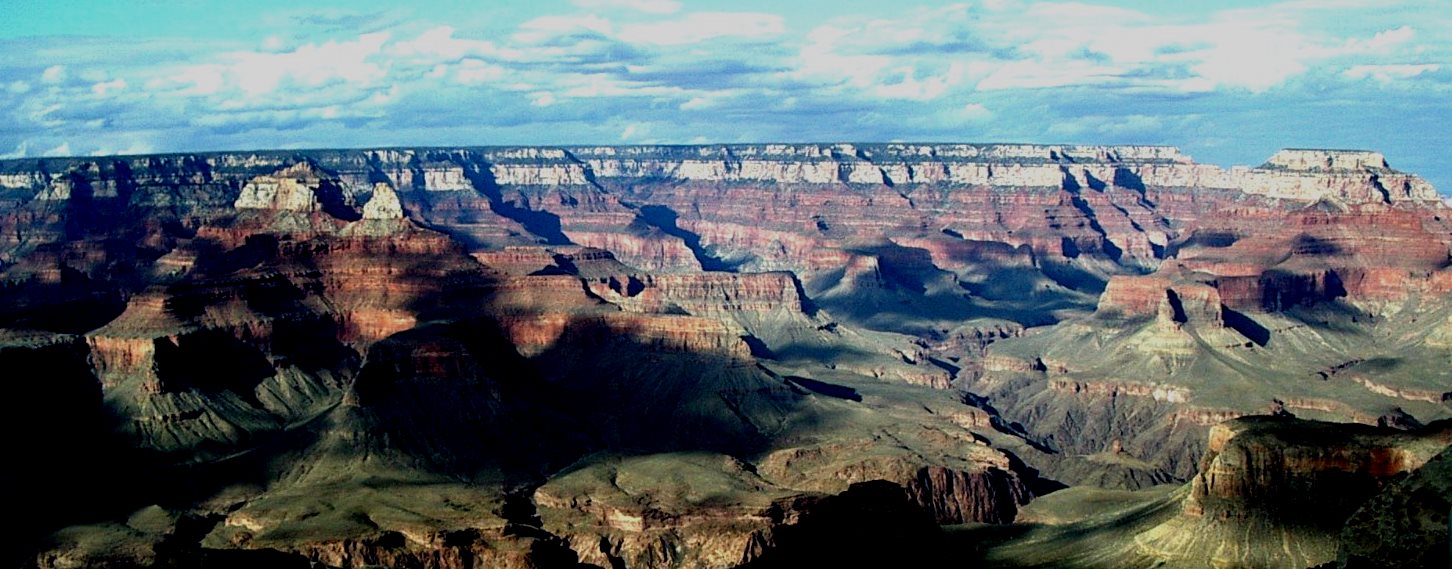](https://paleolimbot.github.io/physical-geology/figures/19-measuring-geological-time/figure-19-1.jpg)
Figure 19.i: Arizona's Grand Coulee is an icon for geological time; one,450 million years are represented by this photograph. The lite-coloured layers of rocks at the meridian formed at ~ 250 Ma, and the dark ones at the bottom of the canyon at ~ ane,700 Ma. Source: Steven Earle (2015) CC Past 4.0 view source
Learning Objectives
After reading this chapter and answering the review questions at the stop, you should be able to:
- Apply bones geological principles to decide the relative ages of rocks.
- Explicate the difference between relative and absolute age-dating techniques.
- Summarize the history of the geological time scale and the relationships between eons, eras, periods, and epochs.
- Understand the importance and significance of unconformities.
- Estimate the age of a stone based on the fossils that it contains.
- Use isotopic data to estimate the absolute age of a rock.
- Describe some applications and limitations of isotopic techniques for accented geological dating.
- Describe the techniques for dating geological materials using tree rings and magnetic data.
- Explain why an understanding of geological time is disquisitional to both geologists and the public in full general.
Fourth dimension is the dimension that sets geology apart from near other sciences. Geological time is vast, and Globe has changed tremendously during this time. Even though most geological processes are very, very slow, the vast amount of time that has passed has allowed for the formation of boggling geological features, as shown in Figure 19.1
We have numerous ways of measuring geological time. We tin tell the relative ages of rocks (e.thou., whether i rock is older than another) based on their spatial relationships, we can use fossils to appointment sedimentary rocks considering nosotros take a detailed record of the evolution of life on Earth, and nosotros tin use a range of isotopic techniques to determine the absolute ages (in millions of years) of igneous and metamorphic rocks.
Simply merely because we can measure geological time doesn't mean that we empathize it. One of the biggest hurdles faced by geology students—and geologists also—in understanding geology is to really come to grips with the slow rates at which geological processes happen, and the vast amount of time involved.
The Geological Timescale
James Hutton (1726-1797) was a Scottish geologist, considered by some to be the male parent of mod Geology. Hutton studied present-day processes and applied his observations to the rock record in order to understand what he saw there. Such a method is now encapsulated in the principle of uniformitarianism, which states that the nowadays is the key to the past. Given that many geological processes that we can see happening around us occur at very wearisome rates, Hutton concluded that geological time must be very long indeed to business relationship for the big changes apparent in the stone tape. But this principle needs to exist taken with a grain of salt: at that place are some processes that have occurred in the by that are no longer occurring (e.g., eruption of ultramafic lavas), as well equally some processes that occur so irregularly that nosotros have not however witnessed such an effect in historic time (eastward.g., bear on of a large asteroid with Earth).
William Smith worked as a surveyor in the coal-mining and canal-building industries in south-western England in the late 1700s and early on 1800s. While doing his work, he had many opportunities to observe Paleozoic and Mesozoic sedimentary rocks of the region, and he did then in a way that few had done earlier. Smith noticed the textural similarities and differences between rocks in different locations. More importantly, he discovered that fossils could be used to correlate rocks of the same age. Smith is credited with formulating the principle of faunal succession, the concept that specific types of organisms lived during different time intervals. He used the principle of faunal succession to great consequence in his monumental project to create a geological map of England and Wales, published in 1815.
Inset into Smith'due south great geological map is a pocket-sized diagram showing a schematic geological cross-section extending from the Thames estuary of eastern England to the west coast of Wales. Smith showed the sequence of rocks, from the Paleozoic rocks of Wales and western England, through the Mesozoic rocks of key England, to the Cenozoic rocks of the expanse effectually London (Figure 19.ii).
._](https://paleolimbot.github.io/physical-geology/figures/19-measuring-geological-time/figure-19-2.png)
Effigy 19.2: William Smith's "Sketch of the succession of strata and their relative altitudes," an inset on his geological map of England and Wales (with era names added). Source: Steven Earle (2015) CC Past iv.0 view source, modified after William Smith (1815) Public Domain view map.
Smith did non put any dates on these rocks, because he didn't know them. Only he was aware of the principle of superposition, the idea developed much earlier by the Danish theologian and scientist Nicholas Steno, that young sedimentary rocks course on elevation of older ones. Therefore, Smith knew that this diagram represented a stratigraphic column. And since almost every period of the Phanerozoic is represented along this section through Wales and England, it is besides a primitive geological time scale.
Smith's piece of work set the phase for the naming and ordering of the geological time periods, which was initiated effectually 1820, first by British geologists, and later on by other European geologists. Many of the periods are named for places where rocks of that age are establish in Europe, such as Cambrian for Cambria in Wales, Devonian for Devon in England, Jurassic for the Jura Mountains in French republic and Switzerland, and Permian for the Perm region of Russia. Some are named for the type of rock that is common during that age, such every bit Carboniferous for the coal-begetting rocks of England, and Cretaceous for the chalks of England and French republic.
The early time scales were simply relative because 19th century geologists did non know the absolute ages of rocks. This information was non available until the development of isotopic dating techniques early in the 20th century.
The geological timescale is currently maintained by the International Committee on Stratigraphy (ICS), which is function of the International Union of Geological Sciences. The time scale is continuously being updated as we learn more most the timing and nature of past geological events. View the ICS timescale.
Geological fourth dimension has been divided into four eons: Hadean, Archean, Proterozoic, and Phanerozoic (Effigy 19.3). The start iii of these eons represent almost 90% of Earth's history. Rocks from the Phanerozoic (meaning "visible life") are the most commonly exposed rocks on Globe, and they contain evidence of life forms with which we are familiar.
_](https://paleolimbot.github.io/physical-geology/figures/19-measuring-geological-time/figure-19-3.png)
Figure xix.3: The eons of World'south history. Source: Karla Panchuk (2018) CC BY 4.0, modified later Steven Earle (2015) CC BY four.0 view source
The Phanerozoic — the by 541 Ma of Globe's history — is divided into 3 eras: the Paleozoic ("early life"), the Mesozoic ("centre life"), and the Cenozoic ("new life"), and each era is divided into periods (Figure xix.4). Most of the organisms with which we share Earth evolved into familiar forms at various times during the Phanerozoic.
_](https://paleolimbot.github.io/physical-geology/figures/19-measuring-geological-time/figure-19-4.png)
Figure 19.four: The eras (heart row) and periods (bottom row) of the Phanerozoic. Source: Karla Panchuk (2018) CC Past 4.0, modified after Steven Earle (2015) CC By 4.0 view source
The Cenozoic, representing the past 66 Ma, is divided into 3 periods, the Paleogene, Neogene, and Quaternary; and vii epochs (Figure xix.5). Non-avian dinosaurs became extinct at the showtime of the Cenozoic, after which birds and mammals radiated to fill the available habitats. Earth was very warm during the early on Eocene, and has cooled steadily ever since. Glaciers first appeared on Antarctica in the Oligocene and then on Greenland in the Miocene. Past the Pleistocene, glaciers covered much of Due north America and Europe. The most recent of the Pleistocene glaciations concluded ~eleven,700 years ago. The electric current epoch is known equally the Holocene. Epochs are further divided into ages.
_](https://paleolimbot.github.io/physical-geology/figures/19-measuring-geological-time/figure-19-5.png)
Figure 19.5: The periods and epochs of the Cenozoic Era. Source: Karla Panchuk (2018) CC BY 4.0, modified after Steven Earle (2015) CC BY 4.0 view source
Most of the boundaries between the periods and epochs of the geological timescale accept been fixed on the basis of significant changes in the fossil record. For example, the boundary between the Cretaceous and the Paleogene coincides exactly with the extinction of the dinosaurs. This is not a coincidence. Many other types of organisms went extinct at this time, and the boundary between the 2 periods marks the segmentation betwixt sedimentary rocks containing Cretaceous organisms below, and those containing Paleogene organisms higher up.
Relative Dating Methods
Relative Dating Principles
The simplest and nigh intuitive manner of dating geological features is to await at the relationships between them. There are a few elementary rules for doing this. But circumspection must exist taken, as there may be situations in which the rules are not valid, so local factors must be understood earlier an interpretation can be made. These situations are generally rare, merely they should not exist forgotten when unraveling the geological history of an expanse.
The principle of superposition states that sedimentary layers are deposited in sequence, and the layers at the lesser are older than those at the top. This situation may non be truthful, though, if the sequence of rocks has been flipped completely over by tectonic processes, or disrupted by faulting.
The principle of original horizontality indicates that sediments are originally deposited every bit horizontal to nearly horizontal sheets. At a broad calibration this is true, just at a smaller scale it may not exist. For example, cross-bedding forms at an observable angle, where sand is deposited upon the lee confront of a ripple. The aforementioned holds true of delta foreset beds (Figure nineteen.6).
_](https://paleolimbot.github.io/physical-geology/figures/19-measuring-geological-time/figure-19-6.png)
Figure 19.6: A cross-department through a river delta forming in a lake. The delta foresets are labeled "Delta deposits" in this figure, and you can rapidly see that the front face up of the foresets are definitely not deposited horizontally. Source: AntanO (2017) CC BY four.0 view source
The principle of lateral continuity states that sediments are deposited such that they extend laterally for some distance earlier thinning and pinching out at the edge of the depositional basin. But sediments can also terminate confronting faults or erosional features (see unconformities below), so may exist cutting off by local factors.
The principle of inclusions states that whatever rock fragments that are included in a rock must be older than the rock in which they are included. For example, a xenolith in an igneous rock, or a clast in sedimentary rock must be older than the rock that includes it (Figure 19.vii). A possible situation that would violate this principle is the following: an igneous dyke may intrude through a sequence of rocks, hence is younger than these rocks (see the principle of cross-cut relationships below). Later deformation may cause the dyke to be pulled apart into pocket-sized pieces, surrounded by the host rocks. This situation can make the pieces of the dyke announced to be xenoliths, but they are younger than the surrounding rock in this case.
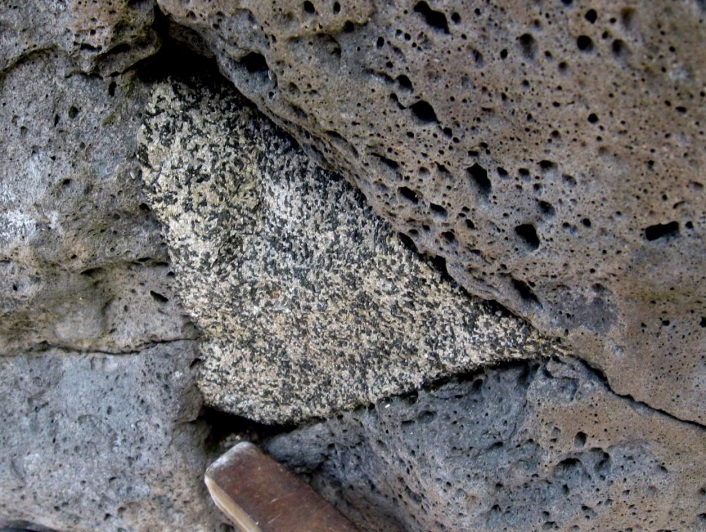/ [right](http://opentextbc.ca/geology/wp-content/uploads/sites/110/2015/07/sandstone.jpg)_](https://paleolimbot.github.io/physical-geology/figures/19-measuring-geological-time/figure-19-7.png)
Figure 19.7: Applications of the principle of inclusion. Left- A xenolith of diorite incorporated into a basalt lava flow, Mauna Kea volcano, Hawai'i. The lava menstruum took identify some fourth dimension after the diorite crystallized (hammer head for scale). Right- Rip-upward clasts of shale embedded in Gabriola Formation sandstone, Gabriola Isle, BC. The pieces of shale were eroded as the sand was deposited, then the shale is older than the sandstone. Source: Karla Panchuk (2018) CC By 4.0. Photographs by Steven Earle (2015) CC BY 4.0 view sources left/ correct
The principle of cross-cutting relationships states that whatsoever geological characteristic that cuts across or disrupts another characteristic must exist younger than the feature that is disrupted. An instance of this is given in Effigy 19.eight, which shows three unlike sedimentary layers. The lower sandstone layer is disrupted by 2 faults, so nosotros tin can infer that the faults are younger than this layer. But the faults practice not appear to go on into the coal seam, and they certainly practise non keep into the upper sandstone. So we can infer that coal seam is younger than the faults (because the coal seam cuts across them). The upper sandstone is youngest of all, because it lies on elevation of the coal seam. An example that violates this principle tin be seen with a type of fault called a growth fault. A growth fault is a fault that continues to move every bit sediments are continuously delivered to the hangingwall cake. In this instance, the lower portion of the mistake that cuts the lower sediments may accept originally formed before the uppermost sediments were deposited, despite the error cutting through all of the sediments, and appearing to be entirely younger than all of the sediments.
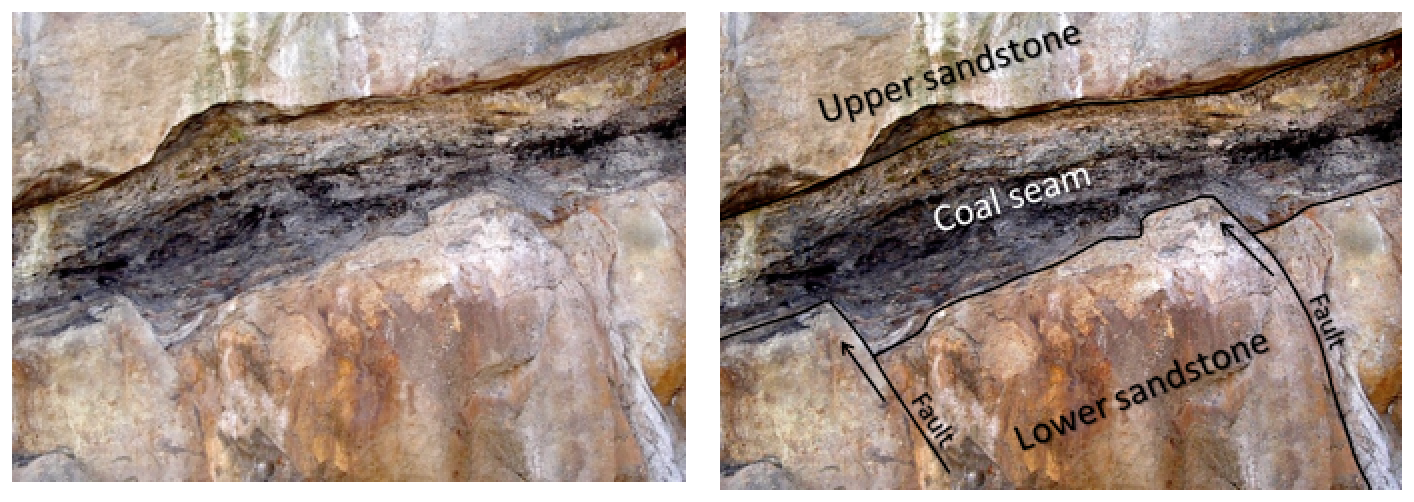_](https://paleolimbot.github.io/physical-geology/figures/19-measuring-geological-time/figure-19-8.png)
Figure nineteen.8: Superposition and cross-cutting relationships in Cretaceous Nanaimo Group rocks in Nanaimo BC. The coal seam is about 50 cm thick. Source: Steven Earle (2015) CC BY iv.0 view source
The principle of broiled contacts states that the heat of an intrusion will broil (metamorphose) the rocks in close proximity to the intrusion. Hence the presence of a baked contact indicates the intrusion is younger than the rocks around it. If an intrusive igneous rock is exposed via erosion, so later buried by sediments, the surrounding rocks will non exist broiled, as the intrusion was already cold at the time of sediment degradation. But baked contacts may be difficult to discern, or may be minimally developed to absent when the intrusive rocks are low in volume or felsic (relatively cool) in composition.
The__ principle of chilled margins__ states that the portion of an intrusion that has cooled and crystallized side by side to cold surrounding rock will form smaller crystals than the portion of the intrusion that cooled more slowly deeper in the instrusion, which will form larger crystals. Smaller crystals generally announced darker in colour than larger crystals, and so a chilled margin appears as a darkening of the intrusive stone towards the surrounding stone. This principle tin can be used to distinguish between an igneous sill, which will accept a chilled margin at acme and bottom, and a subaerial lava menstruation, which volition have a chilled margin only at the bottom.
Practice: Cantankerous-Cutting Relationships
The outcrop in Figure xix.9 has three main rock types:
- Buff/pink felsic intrusive igneous rock nowadays as somewhat irregular masses trending from lower right to upper left
- Dark grey metamorphosed basalt
- A l cm wide calorie-free-grey felsic intrusive igneous dyke extending from the lower left to the upper right – offset in several places Using the principle of cantankerous-cutting relationships outlined to a higher place, decide the relative ages of these 3 rock types.
Note: The near-vertical stripes are blasting drill holes. The epitome is most seven chiliad across.
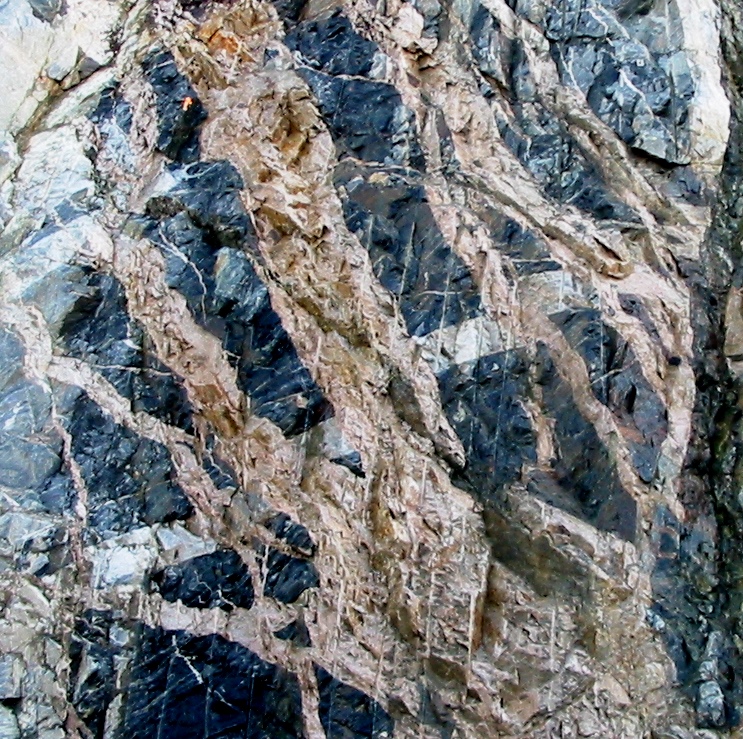_](https://paleolimbot.github.io/physical-geology/figures/19-measuring-geological-time/figure-19-9.jpg)
Effigy 19.9: Outcrop from Horseshoe Bay, BC. Source: Steven Earle CC Past 4.0 view source
Unconformities
An unconformity represents an interruption in the process of deposition of sediments. Recognizing unconformities is of import for understanding time relationships in sedimentary sequences. An unconformity is visible in the Chiliad Canyon (Figure 19.10, white dashed line) higher up Proterozoic rocks that were tilted then eroded to a flat surface prior to deposition of the younger Paleozoic rocks. The difference in fourth dimension between the youngest of the Proterozoic rocks and the oldest of the Paleozoic rocks is nearly 300 million years. Tilting and erosion of the older rocks took place during this time, and if at that place were any deposition occurring in this area during this fourth dimension, erosion removed those sediments.
_](https://paleolimbot.github.io/physical-geology/figures/19-measuring-geological-time/figure-19-10.png)
Figure 19.ten: Angular unconformity in the Grand Canyon in Arizona, with a sketch of rock orientations. The tilted rocks at the bottom are part of the Proterozoic Grand Coulee Grouping (aged 825 to 1,250 Ma). The apartment-lying rocks at the elevation are Paleozoic (540 to 250 Ma). The purlieus between the two (dashed white line) represents a time gap of near 300 million years. Source: Karla Panchuk (2018) CC BY four.0. Photograph past Steven Earle (2015) CC Past iv.0 view source
There are four types of unconformities, reflecting different arrangements and types of rocks higher up and below the surface of non-deposition or erosion (Table xix.1, Figure 19.12).

Effigy xix.11: Types of Unconformities. Source: Karla Panchuk (2018) CC BY 4.0, modified after Steven Earle (2015) CC Past four.0. Click the image for a text version of this table.
_](https://paleolimbot.github.io/physical-geology/figures/19-measuring-geological-time/figure-19-11.png)
Figure nineteen.12: The four types of unconformities: (a) a nonconformity betwixt non-sedimentary stone and sedimentary rock, (b) an angular unconformity, (c) a disconformity between layers of sedimentary stone, where the older stone has been eroded but not tilted, and (d) a paraconformity where at that place is a long menses (millions of years) of non-deposition between ii parallel layers. Source: Steven Earle (2015) CC BY 4.0 view source
Exercise: Relative Dating with Unconformities
- The surfaces G and H in Figure 19.thirteen are unconformities. What kind?
- If erosion at the surface stopped and sediments were deposited once again, what kind of unconformity would be betwixt the layer I and younger rocks?
- Provide a list of the events that afflicted the rocks in Figure 19.13 in club from the oldest event to the most recent event. Note that C and D are faults. The sedimentary rocks labelled A are folded, but the other sedimentary rocks are horizontal.
 _](https://paleolimbot.github.io/physical-geology/figures/19-measuring-geological-time/figure-19-12.png)
Figure 19.13: Block diagram showing sedimentary and igneous rocks affected by faults, folds, and erosion. Source: Karla Panchuk (2018) CC BY-SA iv.0, modified after Woudloper (2009) CC By-SA i.0 view source
Dating Rocks Using Fossils
Geologists obtain a wide range of information from fossils. They aid us to understand evolution, and life in full general; they provide critical information for understanding depositional environments and changes in Globe's climate; and they can be used to date rocks.
Although the recognition of fossils goes back hundreds of years, the systematic cataloguing and assignment of relative ages to different organisms from the distant past—paleontology—only dates back to the primeval part of the 19th century. The oldest undisputed fossils are from rocks dated ~3.5 Ga, and although fossils this sometime are typically poorly preserved and are not useful for dating rocks, they can still provide important data about conditions at the time. The oldest well-understood fossils are from rocks dating back to ~600 Ma, and the sedimentary tape from this fourth dimension frontward is rich in fossil remains that provide a detailed record of the history of life. However, equally anyone who has gone hunting for fossils knows, this does not mean that all sedimentary rocks have visible fossils or that they are piece of cake to find. Fossils alone cannot provide u.s. with numerical ages of rocks, but over the past century geologists have acquired plenty isotopic dates from rocks associated with fossiliferous rocks (such as igneous dykes cutting through sedimentary layers) to be able to put specific time limits on nigh fossils.
A selective history of life on World over the past 600 1000000 years is provided in Effigy 19.fourteen The major groups of organisms that we are familiar with appeared betwixt the late Proterozoic and the Cambrian (~600 Ma to ~541 Ma). Plants, which originally evolved in the oceans every bit light-green algae, invaded land during the Ordovician (~450 Ma). Insects, which evolved from marine arthropods, invaded land during the Devonian (400 Ma), and amphibians (i.e., vertebrates) invaded land about 50 million years afterward. By the tardily Carboniferous, trees had evolved from before plants, and reptiles had evolved from amphibians. By the mid-Triassic, dinosaurs and mammals had evolved from reptiles and reptile ancestors, Birds evolved from dinosaurs during the Jurassic. Flowering plants evolved in the late Jurassic or early Cretaceous. The earliest primates evolved from other mammals in the early Paleogene, and the genus _Homo _evolved during the late Neogene (~2.8 Ma).
_](https://paleolimbot.github.io/physical-geology/figures/19-measuring-geological-time/figure-19-13.png)
Figure 19.14: A selective summary of life on Earth during the late Proterozoic and the Phanerozoic. The pinnacle row shows geological eras, and the lower row shows geological periods. Source: Steven Earle (2015) CC BY 4.0 view source
If nosotros empathize the sequence of development on Earth, nosotros can utilise this cognition to determining the relative ages of rocks. This is William Smith's principle of faunal succession, although in spite of the proper noun, it can utilize to fossils of plants and simple organisms too as to animal (animals).
The Phanerozoic Eon has witnessed five major extinctions (stars in Figure xix.14). The most significant of these was at the cease of the Permian, which saw the extinction of over 80% of all species, and over 90% of all marine species. Most well-known types of organisms that survived were still severely impacted by this result. The 2nd most significant extinction occurred at the Cretaceous-Paleogene purlieus (K-Pg, as well known the Cretaceous-3rd or K-T extinction). At that time, ~75% of marine species disappeared, equally well equally dinosaurs (but not birds) and pterosaurs. Other species were badly reduced just survived, so flourished in the Paleogene. The K-Pg extinction may accept been acquired by the bear upon of a large asteroid (10 km to 15 km in bore) and/or volcanic eruptions associated with the formation of the Deccan Traps, merely it is more often than not agreed that the other iv Phanerozoic mass extinctions had other causes, although their verbal nature is non clearly understood.
It is not a coincidence that the major extinctions all coincide with boundaries of geological periods and/or eras. Paleontologists take placed most of the divisions of the geological fourth dimension scale at points in the fossil record where there are major changes in the blazon of fossils observed.
If we can identify a fossil, and we know when the organism lived, nosotros tin assign a range of fourth dimension to the germination of the sediments in which the organism was preserved when it died. This range might be several millions of years, considering some organisms survived for a very long fourth dimension. If the rock we are studying has several types of fossils in it, and nosotros can assign fourth dimension ranges to all of these fossils, we may be able to narrow the time range for the age of the rock considerably (Figure 19.15).
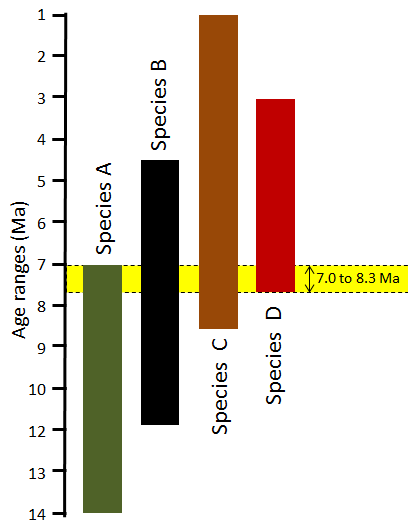_](https://paleolimbot.github.io/physical-geology/figures/19-measuring-geological-time/figure-19-14.png)
Effigy 19.xv: Application of bracketing to constrain the age of a rock based on the presence of several fossils. The xanthous bar represents the time range during which each of the iv species (A – D) existed on Earth. Although each species lived for several millions of years, nosotros can narrow down the age of the stone to a bridge of just 1.3 Ma during which all iv species coexisted. Source: Steven Earle (2015) CC Past 4.0 view source
Some organisms survived for a very long time, and are not particularly useful for dating rocks. Sharks, for case, have existed for over 400 meg years, and the great white shark has survived for 16 million years and then far. Organisms that lived for relatively short fourth dimension periods are particularly useful for dating rocks, especially if they were distributed over a wide geographic area and hence can be used to compare rocks from dissimilar regions. These are known every bit index fossils. In that location is no specific limit on how short the time span has to be for a fossil to qualify as an index fossil. Some such organisms lived for millions of years, and others for much less than a one thousand thousand years.
Some well-studied groups of organisms qualify as __biozone __fossils considering, although the genera and families lived over a long time, each species lived for a relatively short time and tin can be easily distinguished from others on the footing of specific features. For example, ammonites accept a distinctive feature known every bit the suture line, where the internal beat layers that separate the individual chambers (septae) encounter the outer beat out wall (Effigy nineteen.16). These suture lines are sufficiently variable to place species that tin can be used to judge the relative or accented ages of the rocks in which they are institute.
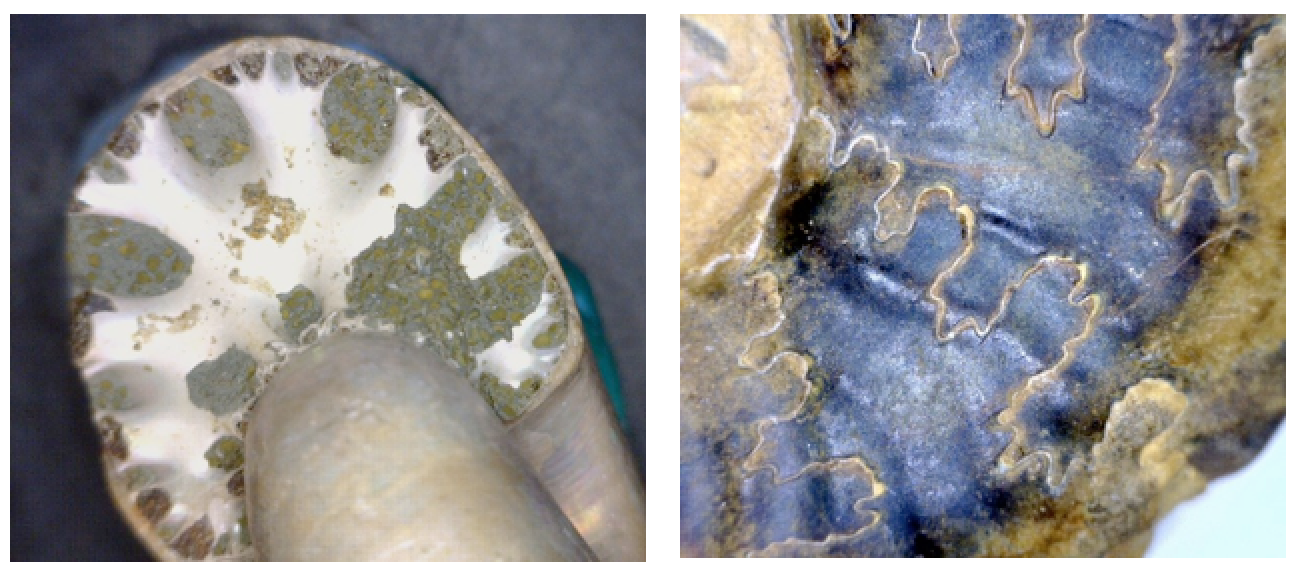_](https://paleolimbot.github.io/physical-geology/figures/19-measuring-geological-time/figure-19-15.png)
Figure nineteen.sixteen: The septum of an ammonite (white part, left), and the suture lines where the septae meet the outer trounce (right). Source: Steven Earle (2015) CC By 4.0 view source
Foraminifera—small, calcium carbonate-shelled marine organisms that originated during the Triassic and are still alive today—are also useful biozone fossils. Numerous dissimilar foraminifera lived during the Cretaceous Period, some for over ten million years, just others for less than 1 million years (Figure 19.17). If the foraminifera in a rock can be identified to the species level, the rock's historic period tin can be adamant.
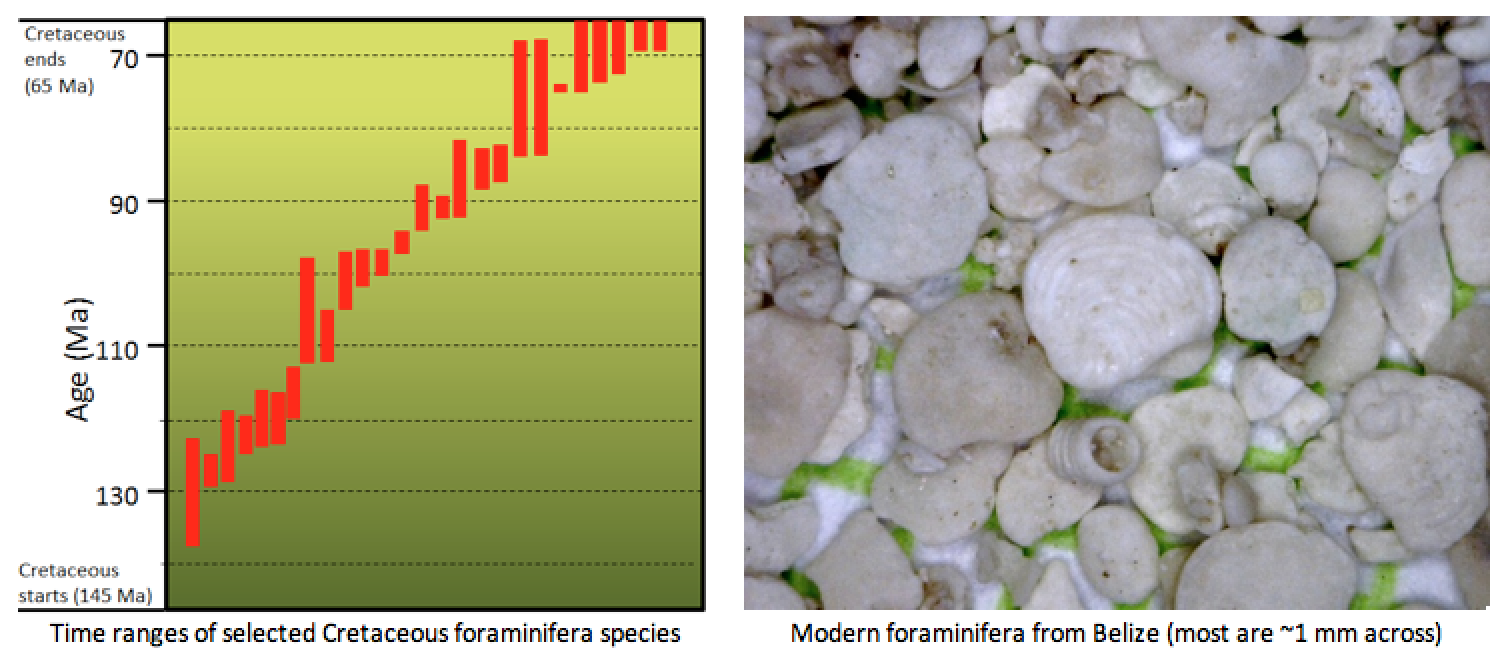](https://paleolimbot.github.io/physical-geology/figures/19-measuring-geological-time/figure-19-16.png)
Figure 19.17: Time ranges for Cretaceous foraminifera (left), and modern foraminifera from the Ambergris area of Belize (right)._ Source: Left- Steven Earle (2015) CC BY four.0, from data in Scott (2014). Right- Steven Earle (2015) CC BY 4.0 _view source
Exercise: Dating Rocks Using Index Fossils
Figure nineteen.eighteen shows the age ranges for some tardily Cretaceous inoceramid clams in the genus Mytiloides. Using the bracketing method described above, decide the possible age range of a rock in which all five of these organisms were found.
How would the age range modify if Grand. subhercynius were not nowadays in the rock?
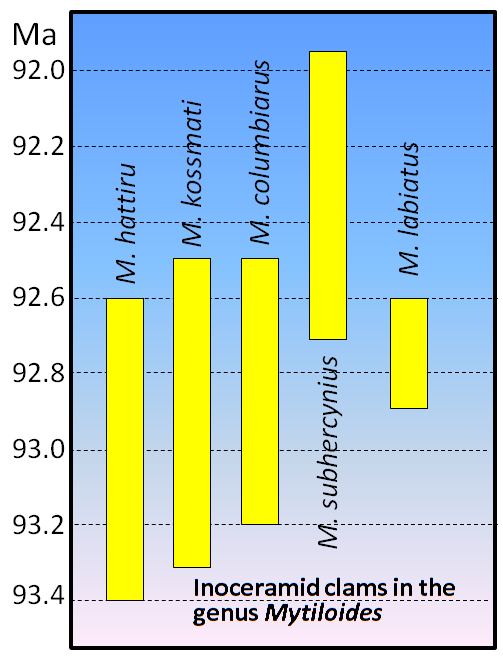_](https://paleolimbot.github.io/physical-geology/figures/19-measuring-geological-time/figure-19-17.png)
Effigy 19.18: Inoceramid ranges. Source: Steven Earle (2015) CC By 4.0, from data in Harries et al. (1996). View source
Correlation
Geologists utilize relative age dating techniques to correlate rocks betwixt regions. Correlation seeks to relate the geological history between regions, by relating the rocks in 1 region to those in another.
At that place are unlike techniques of correlation. The easiest technique is to correlate past rock type, or lithology, called lithostratigraphic correlation. In this method, specific stone types are related betwixt regions. If a sequence of rocks at i site consists of a sandstone unit overlain by a limestone unit of measurement, then a unit of shale, and the exact same sequence of rocks—sandstone, limestone, shale—occurs at a nearby site, lithostratigraphic correlation means bold that the rocks at both sites are in the same rocks. If you could encounter all of the stone exposed between the two sites, the units would connect with 1 another. The problem with this type of correlation is that some rocks may only accept formed locally, or may pinch out between the two sites, and therefore not exist nowadays at the site to which a correlation is beingness attempted.
Another technique, biostratigraphic correlation, involves correlation based on fossil content. This technique uses fossil assemblages (fossils of unlike organisms that occur together) to correlate rocks between regions. The best fossils to use are those that are widely spread, arable, and lived for a relatively brusque menses of fourth dimension.
All the same another technique, chronostratigraphic correlation, is to correlate rocks that take the aforementioned age. This tin can be the most difficult way to correlate, because rocks are more often than not diachronous. That is, if we trace a given rock unit of measurement across any observable lateral distance, the age of that rock actually changes. To give a familiar case, when you go to the beach, you know that the embankment itself and the lake lesser in the shallow water is sandy. But if you swim out to deeper h2o and touch bottom, the bottom feels dingy. The divergence in sediment type has to do with the energy of deposition, with the waves at and near the beach keeping any fine sediments abroad, only depositing them in deeper quieter waters. If yous think of this example in time, you realize that the sand at and near the embankment is existence deposited at the same time as the mud in deeper water. But if lake levels driblet, the beach sands will slowly drift outwards and encompass some of the deeper h2o muds. If lake levels ascent, the deeper water muds will slowly migrate landwards and cover some of the shallower water sands. This is an instance of Walther's Constabulary, which states that sedimentary rocks that we see one on top of each other in the rock record actually formed next to one another at the time of deposition. In social club to correlate rock units in time, we must target marker beds that formed instantaneously. An example of such would be an ash layer from a nearby volcano that erupted and blanketed an unabridged region in ash. Just such marker beds are usually rare to absent, making such correlation extremely difficult.
Isotopic Dating Methods
Isotope Pairs
Originally, fossils only provided u.s. with relative ages considering, although early paleontologists understood biological succession, they did not know the absolute ages of the different organisms. It was only in the early part of the 20th century, when isotopic dating methods were get-go applied, that it became possible to discover the absolute ages of the rocks containing fossils. In most cases, we cannot apply isotopic techniques to directly date fossils or the sedimentary rocks in which they are found, but we can constrain their ages by dating igneous rocks that cut across sedimentary rocks, or volcanic ash layers that lie within sedimentary layers.
Isotopic dating of rocks, or the minerals inside them, is based upon the fact that nosotros know the decay rates of certain unstable isotopes of elements, and that these decay rates have been constant throughout geological time. It is besides based on the premise that when the atoms of an element disuse within a mineral or a rock, they remain trapped in the mineral or rock, and do not escape.
One of the isotope pairs normally used to date rocks is the decay of 401000 to 40Ar (potassium-40 to argon-forty). 401000 is a radioactive isotope of potassium that is present in very small amounts in all minerals that contain potassium. It has a half-life of 1.3 billion years, meaning that over a menstruum of 1.3 Ga half of the 40Yard atoms in a mineral or rock will decay to fortyAr, and over the side by side 1.3 Ga one-half of the remaining atoms will disuse, and and so forth (Figure 19.nineteen). 401000 is called the parent isotope, and 40Ar the daughter isotope, as the parent gives way to the daughter during radioactive disuse.
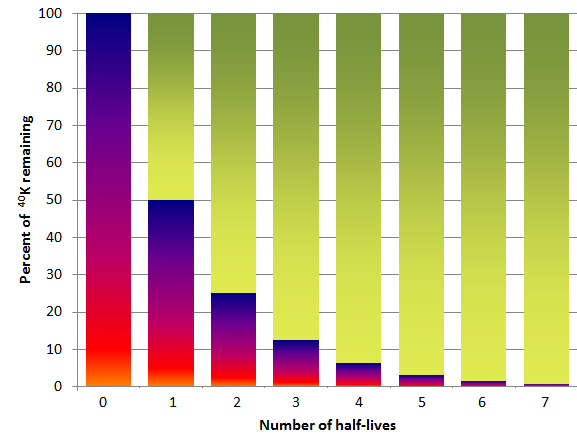_](https://paleolimbot.github.io/physical-geology/figures/19-measuring-geological-time/figure-19-18.png)
Figure nineteen.19: The disuse of 40K over time. Each half-life is 1.3 billion years, so after 3.nine billion years (three one-half-lives) 12.5% of the original fortyGrand will remain. The blood-red-blue bars represent 40Yard and the green-yellowish bars represent twoscoreAr. Source: Steven Earle (2015) CC By 4.0 view source
In order to utilise the Thou-Ar dating technique, we need to take an igneous or metamorphic stone that includes a potassium-begetting mineral. One good example is granite, which contains the mineral potassium feldspar (Effigy 19.20). Potassium feldspar does not contain whatever argon when it forms. Over time, the 40Chiliad in the feldspar decays to 40Ar. The atoms of 40Ar remain embedded within the crystal, unless the rock is subjected to high temperatures after information technology forms. The sample must be analyzed using a very sensitive mass-spectrometer, which can notice the differences between the masses of atoms, and tin can therefore distinguish between 40K and the much more abundant 39K. The minerals biotite and hornblende are as well normally used for Thousand-Ar dating.
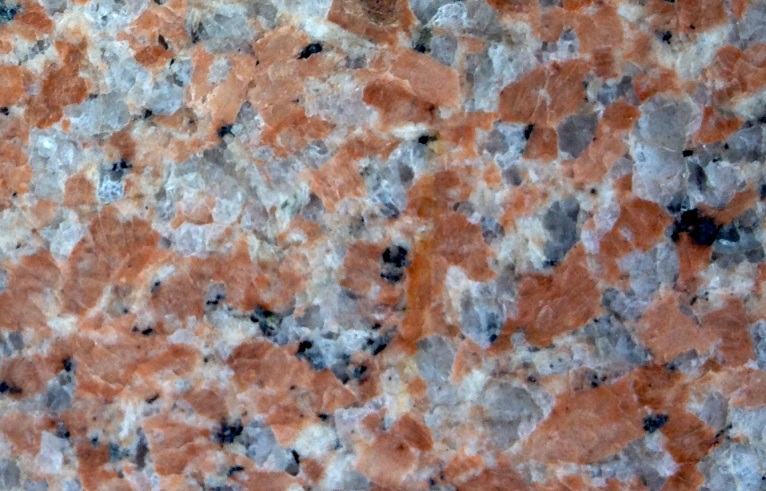_](https://paleolimbot.github.io/physical-geology/figures/19-measuring-geological-time/figure-19-19.jpg)
Figure 19.20: Crystals of potassium feldspar (pink) in a granitic rock are candidates for isotopic dating using the K-Ar method considering they contained potassium and no argon when they formed. Source: Steven Earle (2015) CC BY 4.0 view source
There are many isotope pairs that can exist employed in dating igneous and metamorphic rocks (come across Table nineteen.2), each with its strengths and weaknesses. In the in a higher place instance, the daughter isotope 40Ar is naturally a gas, and tin escape the potassium feldspar quite hands if the feldspar is exposed to heating during metamorphism, or interaction with hydrothermal fluids. Hence we must closely examine the feldspar mineral to decide if at that place is any evidence of alteration. If some xlAr has been lost, but the sample is dated anyway, an age that is likewise young volition be calculated.

Figure 19.21: Commonly used isotope systems for dating geological materials. Source: Steven Earle (2015) CC Past four.0. Click the table for a text version.
Each parent isotope has a certain half-life, which ranges from microseconds to billions of years, depending upon the isotope. In dating rocks, nosotros need to select an isotope pair with a parent isotope that has a reasonable half-life. This means that the half-life must not be too brusk or likewise long. If the one-half-life is as well short, then virtually of the parent isotope will have decayed to grade the daughter isotope. If we cannot measure the corporeality of parent isotope very accurately, which will be impossible to practise if at that place is merely the tiniest amount of parent isotope left, our calculated age will accept huge errors associated with it. The same applies if the half-life is likewise long. In this case, very little of the daughter isotope will take formed, and our inability to measure the pocket-size amount of daughter isotope accurately will once more result in huge errors in our calculated age.
Another complicating factor is whether the mineral of interest incorporated any of the daughter isotope into its structure at the time of formation. When we select a mineral and an isotope pair to engagement that mineral, we make the assumption that all of the daughter isotope we find in the mineral was produced in the mineral past radioactive decay of the parent isotope. But if the mineral formed with some girl isotope already present in its structure, and then the historic period we calculate will be as well old.
A more robust mineral to utilize to date certain types of igneous and metamorphic rocks is zircon. Zircon is a mineral that incorporates uranium into its structure at the time of formation. One of the isotopes of uranium decays to pb with a long one-half-life (see Tabular array 19.two). Zircon is a mineral of choice for dating because information technology takes no lead into its structure when it forms, so any lead present is due entirely to the radioactive decay of the uranium parent. Another reason is considering zircon is a very resistant mineral. It tin can handle exposure to hydrothermal fluids, and all simply the highest grades of metamorphism, and not lose whatever of the parent or daughter isotopes. Hence the age that we calculate tends to be very authentic. One drawback is that zircon tends to form only in felsic igneous rocks. Hence if nosotros are trying to date a mafic igneous stone, nosotros must choose a unlike mineral.
The Meaning of a Radiometric Date
When we employ isotopic methods on minerals we are measuring an age date. Generally, an historic period engagement refers to the fourth dimension since a mineral crystallized from molten rock (magma or lava). This is when the elements that make up the mineral get locked into the mineral's structure. But as nosotros have already seen, elevated temperatures tin crusade elements to escape from a mineral, without the mineral melting. Hence when we engagement a mineral, nosotros may be dating the time since the mineral crystallized from a melt, or the fourth dimension since the mineral last experienced a period of heating above its Curie point, which is the temperature beyond which the mineral is able to lose (or gain) elements from its structure, without melting. So we take to know something about the rock before we forge ahead to measure an age. We may choose a mineral and isotope pair that are very resistant to metamorphism, then that we can "come across through" the metamorphism, and make up one's mind the original age that the mineral crystallized from a melt. Or we may be interested in the age of the metamorphic event itself, so cull a mineral and isotope pair that is susceptible to resetting the isotopic clock during metamorphism (such equally by losing all of the daughter isotope).
Absolute age dating is a powerful tool for unraveling the geological history of a region, merely we accept seen that we must ultimately rely upon igneous rocks (that may have after metamorphosed) for the minerals that nosotros are able to date (see the next department for bug with dating sedimentary rocks directly). Another outcome with absolute age dating is that it is expensive, with a unmarried analysis costing several hundreds of dollars. Hence geologists never forget their relative age dating principles, and are always applying them in the field to determine the sequence of events that formed the rocks in a region.
Practice: Combining Accented Ages with Relative Dating
The historic period dates for three igneous stone layers are given. Use relative dating techniques to determine the age ranges for the sets of sedimentary units A, B, and C.
_](https://paleolimbot.github.io/physical-geology/figures/19-measuring-geological-time/figure-19-20.png)
Figure 19.22: A sequence of igneous and sedimentary layers. Age dates are given for the igneous layers. Source: Karla Panchuk (2018) CC Past-SA 4.0, modified after Jill Curie (2014) CC Past-SA three.0 view source
Isotope Dating Techniques and Sedimentary Rocks
A clastic sedimentary rock (e.g., conglomerate, Effigy nineteen.23) is made up of older rock and mineral fragments. These fragments were derived from weathering and erosion of pre-existing rocks. The process of forming a sedimentary rock from sediments generally occurs at low temperatures, so the minerals are not heated beyond their Curie points. Hence the minerals still preserve their original ages (either igneous crystallization age, or a metamorphic age).
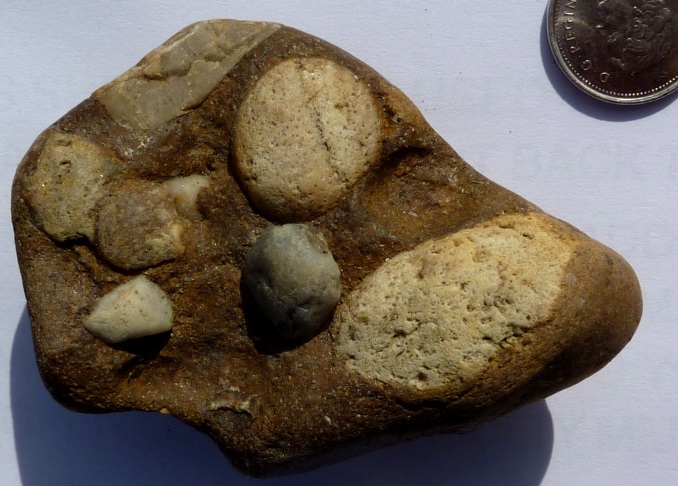_](https://paleolimbot.github.io/physical-geology/figures/19-measuring-geological-time/figure-19-21.jpg)
Figure 19.23: Conglomerate is a sedimentary rock consisting of big rounded clasts surrounded by finer-grained material. Source: Steven Earle (2015) CC By four.0 view source
In almost all cases, the fragments take come from a range of source rocks that all formed at different times. If we dated a number of individual grains in the sedimentary rock, we would probable get a range of different dates, all older than the historic period of the sedimentary rock. The most that such ages gleaned from a sedimentary rock can tell united states is a maximum age of the sedimentary rock. It might be possible to engagement some chemic sedimentary rocks isotopically, but at that place are no useful isotopes that tin can be used on sometime chemical sedimentary rocks.
Radiocarbon Dating
Radiocarbon dating (using 14C) can exist applied to many geological materials, including sediment and sedimentary rocks, merely but if the materials in question are younger than ~60 ka, and contain organic material. Across this time, in that location is so piddling fourteenC left that information technology cannot exist measured accurately, and the resulting age dates are hence unreliable. Fragments of wood incorporated into young sediment are expert candidates for carbon dating, and this technique has been used widely in studies involving late Pleistocene glaciers and glacial sediments. Figure 19.24 shows radiocarbon dates from wood fragments in glacial sediments accept been used to judge the fourth dimension of the final glacial advance forth the Strait of Georgia.
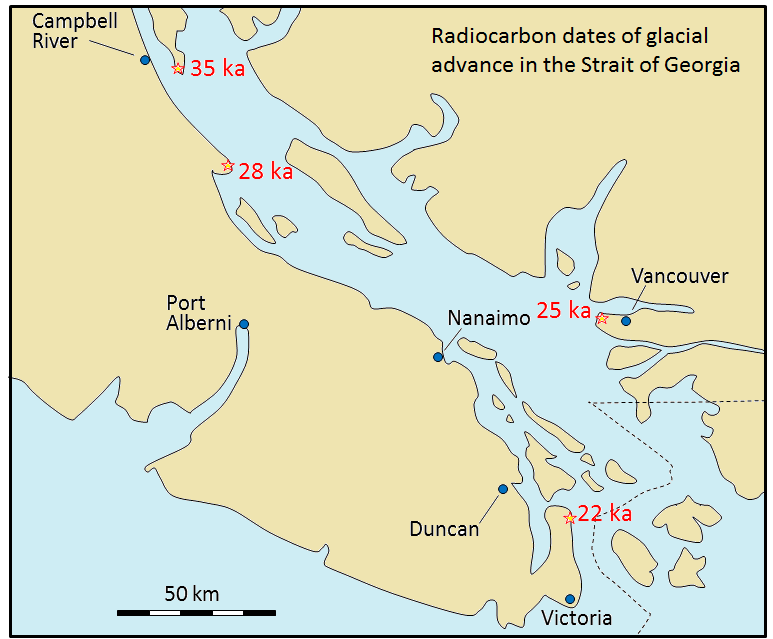, modified after Clague (1976)._](https://paleolimbot.github.io/physical-geology/figures/19-measuring-geological-time/figure-19-22.png)
Effigy 19.24: Radiocarbon dates on forest fragments in glacial sediments in the Strait of Georgia. Source: Steven Earle (2015) CC BY iv.0 view source, modified afterward Clague (1976).
Practice: Radiometric Dating with Potassium-Argon
Assume that a feldspar crystal from the granite shown in Effigy 19.20 was analyzed for 401000 and xlAr. The proportion of 40K remaining is 0.91. Using the disuse bend shown on this graph, judge the age of the rock. An example is provided (in blue) for a 40K proportion of 0.95, which is equivalent to an age of approximately 96 Ma. This is determined by drawing a horizontal line from 0.95 to the decay curve line, and then a vertical line from at that place to the fourth dimension axis.
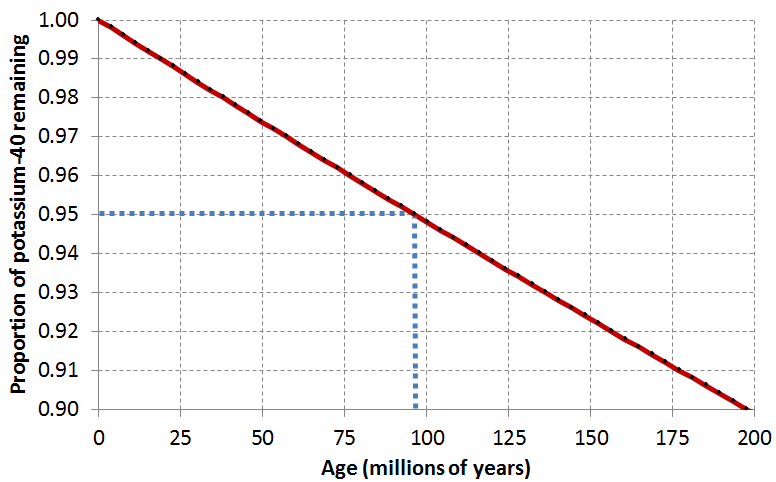_](https://paleolimbot.github.io/physical-geology/figures/19-measuring-geological-time/figure-19-23.png)
Figure nineteen.25: Decay bend for potassium-argon dating. Source: Steven Earle (2015) CC By 4.0 view source
Other Dating Methods
There are numerous other techniques for dating geological materials, but we will examine only ii of them here: dendrochronology—tree-ring dating—and dating based on the record of reversals of Earth's magnetic field.
Dendrochronology
Dendrochronology can be applied to dating very immature geological materials based on reference records of tree-band growth going back many millennia. The longest such records can take the states back over 25 ka, to the height of the final glaciation. One of the advantages of dendrochronology is that, providing reliable reference records are available, the technique tin can exist used to engagement events to the nearest twelvemonth.
Dendrochronology has been used to date the final major subduction zone earthquake on the coast of B.C., Washington, and Oregon. When big earthquakes occur in this region, there is a trend for some littoral areas to subside by one or two metres. Seawater then rushes in, flooding littoral flats and killing trees and other vegetation within a few months. There are at least four locations along the coast of Washington that have such dead copse, and probably many more in other areas. Wood samples from these trees have been studied and the ring patterns have been compared with patterns from old living trees in the region (Figure nineteen.26).
_](https://paleolimbot.github.io/physical-geology/figures/19-measuring-geological-time/figure-19-24.png)
Figure nineteen.26: Case of tree-ring dating of dead trees. Source: Steven Earle (2015) CC By four.0 view source
At all of the locations studied, the trees were plant to have died either in the twelvemonth 1699, or very shortly thereafter (Effigy nineteen.27). On the basis of these results, it was ended that a major earthquake took place in this region sometime between the end of growing season in 1699 and the beginning of the growing flavor in 1700. Evidence from a major tsunami that struck Japan on January 27, 1700, narrowed the timing of the earthquake to sometime in the evening of January 26, 1700. (For more than data, see https://web.viu.ca/earle/1700-convulse/.)
, from data in Yamaguchi et al. (1997)._](https://paleolimbot.github.io/physical-geology/figures/19-measuring-geological-time/figure-19-25.png)
Effigy nineteen.27: Sites in Washington where dead trees are present in coastal flats. The outermost wood of eight copse was dated using tree-ring dating, and of these, seven died during the year 1699, suggesting that the country was inundated by water at this fourth dimension. Source: Steven Earle (2015) CC Past 4.0 view source, from data in Yamaguchi et al. (1997).
Magnetic Chronology
Changes in Earth'south magnetic field tin can also be used to engagement events in geologic history. The magnetic field causes compass needles point toward the north magnetic pole, only this hasn't e'er been the case. At diverse times in the by, Earth's magnetic field has reversed its polarity, and during such times a compass needle would have pointed to the south magnetic pole. Past studying magnetism in volcanic rocks that have been dated isotopically, geologists take been able to institute the chronology of magnetic field reversals going back for ~250 Ma. About 5 Ma of this record is shown in Effigy xix.28, where the black bands represent periods of normal magnetism ("normal" pregnant a polarity identical to the electric current magnetic field) and the white bands stand for periods of reversed magnetic polarity. These periods of consistent magnetic polarity are given names to brand them easier to reference. The current menstruum of normal magnetic polarity, known as Brunhes, has lasted for the past 780,000 years. Prior to that at that place was a brusk reversed period and and then a brusque normal period, the latter of which is known equally Jaramillo.
_](https://paleolimbot.github.io/physical-geology/figures/19-measuring-geological-time/figure-19-26.png)
Figure nineteen.28: The last five Ma of magnetic field reversals. Source: Steven Earle (2015) CC By 4.0 view source, modified after U.S. Geological Survey (2007) Public Domain view source
Oceanic chaff becomes magnetized by the magnetic field that exists as the crust forms from magma at mid-body of water ridges. As it cools, the magnetic fields of tiny crystals of magnetite that form within the magma become aligned with the existing magnetic field, and remain in this orientation, even if World's magnetic field subsequently changes polarity (Figure 19.29). Oceanic crust that is forming today is beingness magnetized in a "normal" sense, simply chaff that formed 780,000 to 900,000 years ago, in the interval between the Brunhes and Jaramillo normal periods, was magnetized in the "reversed" sense.
_](https://paleolimbot.github.io/physical-geology/figures/19-measuring-geological-time/figure-19-27.png)
Figure 19.29: Formation of magnetized oceanic crust at a spreading ridge. Coloured bars represent periods of normal magnetic polarity. Capital letters denote the Brunhes, Jaramillio, Olduvai, and Gauss normal magnetic periods (come across Effigy xix.28). Source: Steven Earle (2015) CC By 4.0 view source
Magnetic chronology tin can be used as a dating technique because we tin can measure the magnetic field of rocks using a magnetometer, or of entire regions by towing a magnetometer behind a ship or an plane. For case, the Juan de Fuca Plate, which lies off of the due west coast of BC, Washington, and Oregon, is being and has been formed forth the Juan de Fuca spreading ridge (Figure 19.thirty). The parts of the plate that are still close to the ridge exhibit normal magnetic polarity, while parts that are further abroad (and formed much earlier) take either normal or reversed magnetic polarity, depending upon when the stone formed. By carefully matching the sea-floor magnetic stripes with the known magnetic chronology, we can make up one's mind the age at any point on the plate. We can see that the oldest office of the Juan de Fuca Plate that has not notwithstanding subducted (off of the coast of Oregon) is merely over 8 million years erstwhile, while the part that is subducting beneath Vancouver Island is between 0 and ~six 1000000 years erstwhile.
_](https://paleolimbot.github.io/physical-geology/figures/19-measuring-geological-time/figure-19-28.png)
Figure 19.xxx: TThe pattern of magnetism within the surface area of the Juan de Fuca Plate, off the westward coast of North America. Coloured bands represent parts of the sea floor with normal magnetic polarity, and the magnetic fourth dimension calibration is shown using these same colours. Source: Steven Earle (2015) CC By 4.0 view source
Exercise: Magnetic Dating
The fact that magnetic intervals can just exist either normal or reversed places significant limits on the applicability of magnetic dating. If we find a rock with normal magnetism, we can't know which normal magnetic interval it represents, unless we have some other information.
Using Figure 19.28 for reference, determine the historic period of a rock with normal magnetism that has been constitute to be between 1.v and two.0 Ma based on fossil evidence in nearby sedimentary rocks.
How old is a rock that is express to 2.half-dozen to 3.2 Ma by fossils, and which has reversed magnetic polarity?
Understanding Geological Time
It is one thing to know the facts about geological time — how long it is, how we mensurate it, how we divide it into smaller time intervals, and what nosotros call the various periods and epochs — just information technology is quite some other to really understand geological time. The trouble is that our lives are short and our memories are even shorter. Our experiences bridge only a few decades, so we really don't have a way of knowing what 11,700 years means. What'due south more, information technology is hard for us to understand how 11,700 years differs from 65.five Ma, or even from i.eight Ga. It is not that nosotros cannot comprehend what the numbers mean, it is that nosotros cannot really capeesh how much time is involved.
You may wonder why information technology is and then important to understand geological time. There are some very good reasons. One is so that nosotros can fully empathize how geological processes that seem impossibly slow can produce annihilation of effect. Consider driving from one major city to some other, where a journey of several hours might occur at speeds of ~100 km/h. Continents motion toward each other at rates of a fraction of a millimetre per day, a speed something on the society of 0.00000001 km/h, and yet, at this impossibly slow rate (endeavour walking at this speed!), they tin move thousands of kilometres through geological time. Sediments typically accumulate at fifty-fifty slower rates — less than a millimetre per year — merely still they are thick plenty to exist thrust upward to form huge mountains or carved into scenic canyons.
Another reason is to understand problems like extinction of endangered species, and human influence on climate. People who do not sympathize geological time are quick to say that the climate has changed in the past, and that what is happening now is no different. And climate certainly has changed in the past: from the Eocene (50 Ma) to the present day, Earth's climate cooled by ~12°C on average. This is a huge change that ranks as 1 of the most of import climate changes of Earth'due south past, and yet the rate of change over this time was only 0.000024 °C/century. Recent warming has occurred at a rate of ~1.1°C over the past 100 years (NASA GISS), 45,800 times faster than the charge per unit of climate change since the Eocene.
One mode to wrap your heed effectually geological time is to put it into the perspective of single year. At this rate, each hour of the year is equivalent to approximately 500,000 years, and each solar day is equivalent to 12.5 million years. If all of geological time is compressed down into a single year, Earth formed on January 1, and the first life forms evolved in tardily March (~3,500 Ma). The beginning multicellular life forms appeared on November 13 (~600 Ma), plants appeared on land on Nov 24, and amphibians on December three. Reptiles evolved from amphibians during the commencement week of December, and dinosaurs and early mammals evolved past Dec 13. Not-avian dinosaurs, which survived for 160 million years, went extinct on Boxing Mean solar day (Dec 26). The Pleistocene glaciation began at ~6:30 p.g. on New year'south Eve, and the last glacial ice melted from southern Canada by 11:59 p.yard.
It is worth repeating: on this time scale, the earliest ancestors of the animals and plants with which we are familiar did not announced on Earth until mid-November, the dinosaurs disappeared after Christmas, and most of Canada was periodically locked in ice from half-dozen:30 to 11:59 p.m. on New year's Eve. As for people, the offset to inhabit Canada arrived about ane minute before midnight.
Exercise: What Happened on Your Altogether?
Using the "all of geological time compressed to 1 year" concept, determine the geological date that is equivalent to your birthday. Kickoff, go hereto find out which day of the year your nascence appointment is. Carve up that number by 365, and multiply that number past 4,570 to determine the time (in millions since the starting time of geological time). Subtract that number from 4,570 to determine the date back from the present.
Example: April Fool's Twenty-four hours (April one) is day 91 of the year: 91/365 = 0.2493. 0.2493 x 4,570 = 1,139 1000000 years from the start of time, and four,570 - 1,193 = 3,377 Ma is the geological date.
Finally, go to the Foundation for Global Community'south Walk through Time website to find out what was happening on your twenty-four hour period. The nearest date to 3,377 Ma is 3,400 Ma.
Summary
The topics covered in this affiliate can be summarized as follows:
The Geological Fourth dimension Scale
The piece of work of William Smith was critical to the establishment of the first geological timescale early in the 19thursday century, just information technology wasn't until the 20th century that geologists were able to assign reliable dates to the various fourth dimension periods. The geological timescale is now maintained by the International Committee on Stratigraphy. Geological time is divided into eons, eras, periods, and epochs.
Relative Dating Methods
Nosotros tin can determine the relative ages of unlike rocks by observing and interpreting relationships amid them, such as superposition, cross-cutting, and inclusions. Gaps in the geological record are represented by various types of unconformities.
Dating Rocks Using Fossils
Fossils are useful for dating rocks back to ~600 Ma. If we know the age range of a fossil, we can date the stone in which information technology is found, simply some organisms lived for many millions of years. Index fossils stand for shorter geological time spans, and if a rock has several different fossils with known age ranges, we tin narrow the fourth dimension during which the rock formed.
Isotopic Dating Methods
Radioactive isotopes decay at abiding known rates, and can exist used to date igneous and metamorphic rocks. Some commonly used isotope systems are potassium-argon, rubidium-strontium, uranium-atomic number 82, and carbon-nitrogen. Radiocarbon dating can exist applied to sediments and sedimentary rocks, but only if they are younger than 60 ka, and contain organic material, or minerals of calcium carbonate.
Other Dating Methods
There are many other methods for dating geological materials. Two that are widely used are tree-ring dating and magnetic chronology. Dendrochronology, based on studies of tree rings, is widely applied to dating glacial events. Magnetic chronology is based on the known record of Earth'south magnetic field reversals.
Understanding Geological Time
While agreement geological time is relatively easy, really comprehending the significance of the vast amounts of geological time is a groovy challenge. To be able to solve of import geological problems and certain societal challenges, we demand to really appreciate the vastness of geological time.
Chapter Review Questions
-
A granitic rock contains inclusions (xenoliths) of basalt. What can yous say well-nigh the relative ages of the granite and the basalt?
-
Explain the differences betwixt a) disconformity and paraconformity; and b) nonconformity and angular unconformity
-
What are the features of a useful alphabetize fossil?
-
Effigy 19.31 shows a geological cross-section. The granitic rock F at the bottom is the rock that you estimated the historic period of in the practise in xix.4, Radiometric Dating with Potassium-Argon. A piece of forest from layer D has been sent for radiocarbon dating and the result was 0.55 xivC remaining. How one-time is layer D?
-
Based on your answer to question 4, what can y'all say about the historic period of layer C in the figure to a higher place?
-
What blazon of unconformity exists between layer C and rock F?
-
What type of unconformity exists between layer C and rock B?
-
Nosotros cannot utilize magnetic chronology to date annihilation older than ~780,000 years. Why?
-
How did William Smith utilise the principle of faunal succession to make up one's mind the relative ages of the sedimentary rocks of England and Wales?
-
Access a copy of the geological fourth dimension scale at http://www.stratigraphy.org/alphabetize.php/ics-chart-timescale. What are the names of the last age of the Cretaceous and the start age of the Paleogene? Print out the time scale and stick it on the wall in a higher place your desk!
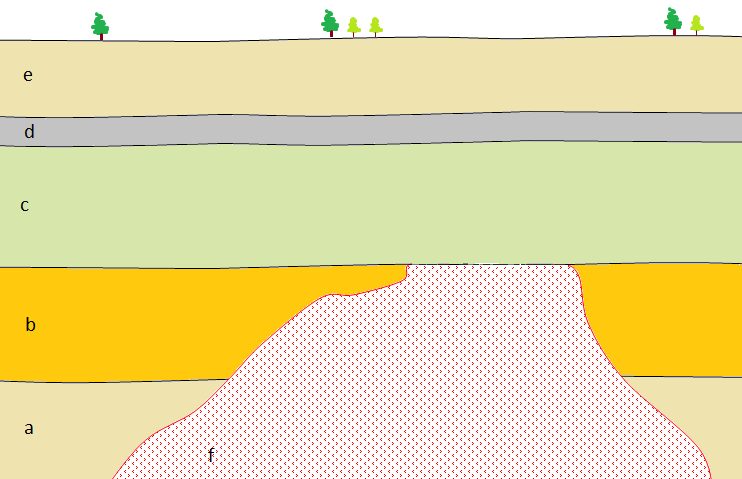. Right- Steven Earle (2015) CC BY 4.0 [view source](http://opentextbc.ca/geology/wp-content/uploads/sites/110/2015/07/diagram.png)_](https://paleolimbot.github.io/physical-geology/figures/19-measuring-geological-time/figure-19-29.png)
Figure xix.31: Geological cantankerous-section (left) and decay curve for 14C ages. Source: Left- Karla Panchuk (2018) CC BY 4.0, modified after Steven Earle (2015) CC BY four.0 view source. Right- Steven Earle (2015) CC Past 4.0 view source
Answers to Chapter Review Questions
-
Xenoliths of basalt within a granite must be older than the granite according to the principle of inclusions.
-
- At both disconformities and paraconformities the beds above and below are parallel, only at a disconformity at that place is articulate show of an erosion surface (the lower layers accept been eroded). (b) A nonconformity is a boundary betwixt sedimentary rocks above and non-sedimentary rocks below while an angular unconformity is a boundary between sedimentary rocks above and tilted and eroded and sedimentary layers below.
-
A useful index fossil must have survived for a relatively short menstruation (e.chiliad., around a meg years), and also should have a wide distribution so that it can be used to correlate rocks from different regions.
-
The granitic stone F has been dated to 175 Ma. The wood in layer D is approximately 5,000 years old, so nosotros can assume that layer D is no older than that, although it could exist as much every bit a few hundred years younger if the wood was already sometime when it got incorporated into the rock.
-
Layer C must exist between five,000 y and 275 Ma.
-
The unconformity between layer C and stone F is a nonconformity.
-
The granite (F) was eroded prior to deposition of C, then it's likely that layer B was also eroded at the same time. If and so, that makes the purlieus between C and B a disconformity.
-
The concluding magnetic reversal was 780,000 years ago, then all rock formed since that time is normally magnetized and information technology isn't possible to distinguish older rock from younger rock inside that time period using magnetic data.
-
William Smith was familiar with the different diagnostic fossils of the rocks of England and Wales and was able to use them to place rocks of different ages.
-
The terminal historic period of the Cretaceous is the Maastrichtian (71.2 to 66.0 Ma) and the beginning age of the Paleogene is the Danian (66.0 to 61.6 Ma).
References
Smith, W. (1815). A delineation of the strata of England and Wales with part of Scotland [map].
Harries, P.J., Kauffman, East.G., Crampton, J.S. (Redacteurs), Bengtson, P., Cech, S., Crame, J.A., Dhondt, A.V., Ernst, K., Hilbrecht, H., Lopez, Mortimore, Yard.R., Tröger, M.-A., Walaszcyk, I., & Wood, C.J. (1996). Mitteilungen aus dem Geologisch - Paläontologischen Museum der Universität Hamburg, 77, 641-671.Full text
Scott, R. (2014). A Cretaceous chronostratigraphic database: construction and applications, Carnets de Géologie, fourteen(2), 15-37. Full text
Clague, J. (1976). Quadra Sand and its relation to late Wisconsin glaciation of southeast British Columbia. Canadian Journal of Globe Sciences, thirteen, 803-815.
Yamaguchi, D.K., Atwater, B.F., Bunker, D.E., Benson, B.E., & Reid, 1000. S. (1997). Dendrochronology the 1700 Cascadia earthquake. Nature, 389, 922 - 923.
NASA Goddard Establish for Space Studies (n.d.). GLOBAL Station Temperature Index in 0.01 degrees Celsius base catamenia: 1951-1980 [data file]. Retrieved from http://data.giss.nasa.gov/gistemp/tabledata_v3/GLB.Ts.txt
Source: https://paleolimbot.github.io/physical-geology/measuring-geological-time.html
0 Response to "what two scales do geologists use to measure time"
Post a Comment